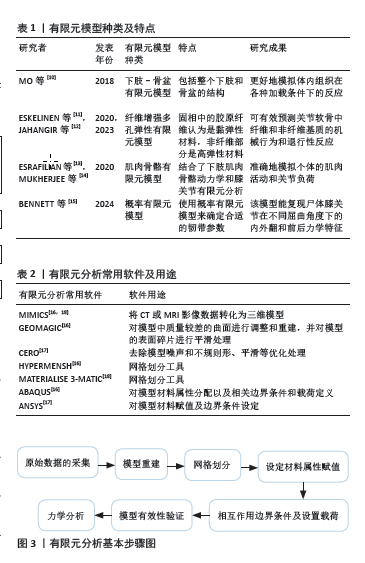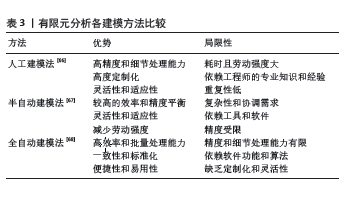[1] BENOS L, STANEV D, SPYROU L, et al. A review on finite element modeling and simulation of the anterior cruciate ligament reconstruction. Front Bioeng Biotechnol. 2020;8:967.
[2] HASSEBROCK JD, GULBRANDSEN MT, ASPREY WL, et al. Knee ligament anatomy and biomechanics. Sports Med Arthrosc Rev. 2020;28(3): 80-86.
[3] YAN M, LIANG T, ZHAO H, et al. Model properties and clinical application in the finite element analysis of knee joint: a review. Orthop Surg. 2024;16(2):289-302.
[4] POPESCU R, HARITINIAN EG, CRISTEA S. Relevance of finite element in total knee arthroplasty-literature review. Chirurgia (Bucur). 2019; 114(4):437-442.
[5] WELCH-PHILLIPS A, GIBBONS D, AHERN DP, et al. What is finite element analysis? Clin Spine Surg. 2020;33(8):323-324.
[6] BREKELMANS WA, POORT HW, SLOOFF TJ. A new method to analyse the mechanical behaviour of skeletal parts. Acta Orthop Scand. 1972; 43(5):301-317.
[7] RYBICKI EF, SIMONEN FA, WEIS EB JR. On the mathematical analysis of stress in the human femur. J Biomech. 1972;5(2):203-215.
[8] CHAND R, HAUG E, RIM K. Stresses in the human knee joint. J Biomech. 1976;9(6):417-422.
[9] SHU L, YAMAMOTO K, YOSHIZAKI R, et al. Multiscale finite element musculoskeletal model for intact knee dynamics. Comput Biol Med. 2022;141:105023.
[10] MO F, LI F, BEHR M, et al. A lower limb-pelvis finite element model with 3D active muscles. Ann Biomed Eng. 2018;46(1):86-96.
[11] ESKELINEN ASA, TANSKA P, FLOREA C, et al. Mechanobiological model for simulation of injured cartilage degradation via pro-inflammatory cytokines and mechanical stimulus. PLoS Comput Biol. 2020;16(6):e1007998.
[12] JAHANGIR S, ESRAFILIAN A, EBRAHIMI M, et al. Sensitivity of simulated knee joint mechanics to selected human and bovine fibril-reinforced poroelastic material properties. J Biomech. 2023; 160:111800.
[13] ESRAFILIAN A, STENROTH L, MONONEN ME, et al. EMG-assisted muscle force driven finite element model of the knee joint with fibril-reinforced poroelastic cartilages and menisci. Sci Rep. 2020; 10(1):3026.
[14] MUKHERJEE S, NAZEMI M, JONKERS I, et al. Use of computational modeling to study joint degeneration: a review. Front Bioeng Biotechnol. 2020;8:93.
[15] BENNETT KJ, FOROUTAN P, FAIRWEATHER E, et al. Development and validation of a biomechanically fidelic surgical training knee model. J Orthop Res. 2024. doi:10.1002/jor.25873.
[16] REN S, SHI H, LIU Z, et al. Finite element analysis and experimental validation of the anterior cruciate ligament and implications for the injury mechanism. Bioengineering (Basel). 2022;9(10):590.
[17] 刘清华,蔡永强,金凤,等.CT数据建立12岁儿童全颈椎有限元模型及有效性验证[J].中国组织工程研究,2023,27(4):500-504.
[18] ZHU LY, LI L, LI ZA, et al. Design and biomechanical characteristics of porous meniscal implant structures using triply periodic minimal surfaces. J Transl Med. 2019;17(1):89.
[19] SODHI N, JACOFSKY DJ, CHEE A, et al. Benefits of CT scanning for the management of knee arthritis and arthroplasty. J Knee Surg. 2021; 34(12):1296-1303.
[20] OMOUMI P, MERCIER GA, LECOUVET F, et al. CT arthrography, MR arthrography, PET, and scintigraphy in osteoarthritis. Radiol Clin North Am. 2009;47(4):595-615.
[21] BENDJABALLAH MZ, SHIRAZI-ADL A, ZUKOR DJ. Finite element analysis of human knee joint in varus-valgus. Clin Biomech (Bristol, Avon). 1997;12(3):139-148.
[22] PEÑA E, CALVO B, MARTÍNEZ MA, et al. A three-dimensional finite element analysis of the combined behavior of ligaments and menisci in the healthy human knee joint. J Biomech. 2006;39(9):1686-1701.
[23] DONG Y, MOU Z, HUANG Z, et al. Three-dimensional reconstruction of subject-specific knee joint using computed tomography and magnetic resonance imaging image data fusions. Proc Inst Mech Eng H. 2013;227(10):1083-1093.
[24] 张吉超,董万鹏,董跃福,等.膝关节有限元模型参数设置[J].中国组织工程研究,2021,25(30):4781-4786.
[25] LIU W, SUN X, LIU W, et al. Finite element study of a partial meniscectomy of a complete discoid lateral meniscus in adults. Med Eng Phys. 2022;107:103855.
[26] LAMPEN N, SU H, CHAN DD, et al. Finite element modeling with subject-specific mechanical properties to assess knee osteoarthritis initiation and progression. J Orthop Res. 2023;41(1):72-83.
[27] LAMPEN N, SU H, CHAN DD, et al. T2 mapping refined finite element modeling to predict knee osteoarthritis progression. Annu Int Conf IEEE Eng Med Biol Soc. 2021;2021:4592-4595.
[28] KARIMI DASTGERDI A, ESRAFILIAN A, CARTY CP, et al. Validation and evaluation of subject-specific finite element models of the pediatric knee. Sci Rep. 2023;13(1):18328.
[29] MALLINOS A, JONES K, DAVIS B. Pivot shift and lachman test simulation-based exploration in juvenile populations for accurately predicting anterior tibial translation. J Biomech. 2022;136:111069.
[30] SUN J, YAN S, JIANG Y, et al. Finite element analysis of the valgus knee joint of an obese child. Biomed Eng Online. 2016;15(Suppl 2):158.
[31] 张刘会,刘丹平.膝关节三维有限元模型建立和验证及模拟后交叉韧带重建术[J].生物医学工程与临床,2020,24(5):508-513.
[32] CROSS M, SMITH E, HOY D, et al. The global burden of hip and knee osteoarthritis: estimates from the global burden of disease 2010 study. Ann Rheum Dis. 2014;73(7):1323-1330.
[33] LAWRENCE RC, FELSON DT, HELMICK CG, et al. Estimates of the prevalence of arthritis and other rheumatic conditions in the united states. part II. Arthritis Rheum. 2008;58(1):26-35.
[34] IIJIMA H, AOYAMA T, FUKUTANI N, et al. Psychological health is associated with knee pain and physical function in patients with knee osteoarthritis: an exploratory cross-sectional study. BMC Psychol. 2018;6(1):19.
[35] 黄振宇,董跃福,胡广洪,等.基于有限元方法的正常和早期OA膝关节生物力学行为比较[J].中国数字医学,2015,10(5):6-9.
[36] KATZ JN, ARANT KR, LOESER RF. Diagnosis and treatment of hip and knee osteoarthritis: a review. JAMA. 2021;325(6):568-578.
[37] ŁUCZKIEWICZ P, DASZKIEWICZ K, CHRÓŚCIELEWSKI J, et al. The influence of articular cartilage thickness reduction on meniscus biomechanics. PLoS One. 2016;11(12):e0167733.
[38] KRAUSE WR, POPE MH, JOHNSON RJ, et al. Mechanical changes in the knee after meniscectomy. J Bone Joint Surg Am. 1976;58(5): 599-604.
[39] WALKER PS, ERKMAN MJ. The role of the menisci in force transmission across the knee. Clin Orthop Relat Res. 1975;(109): 184-192.
[40] WILLINGER L, FOEHR P, ACHTNICH A, et al. Effect of lower limb alignment in medial meniscus-deficient knees on tibiofemoral contact pressure. Orthop J Sports Med. 2019;7(2): 2325967118824611.
[41] DASZKIEWICZ K, ŁUCZKIEWICZ P. Biomechanics of the medial meniscus in the osteoarthritic knee joint. Peer J. 2021;9:e12509.
[42] LI L, YANG X, YANG L, et al. Biomechanical analysis of the effect of medial meniscus degenerative and traumatic lesions on the knee joint. Am J Transl Res. 2019;11(2):542-556.
[43] PERRIMAN A, LEAHY E, SEMCIW AI. The effect of open- versus closed-kinetic-chain exercises on anterior tibial laxity, strength, and function following anterior cruciate ligament reconstruction: a systematic review and meta-analysis. J Orthop Sports Phys Ther. 2018;48(7): 552-566.
[44] DONG Z, YANG C, ZHANG D, et al. The application of human medical image-based finite element analysis in the construction of mouse osteoarthritis models. Heliyon. 2024;10(4):e26226.
[45] CHEUNG EC, DILALLO M, FEELEY BT, et al. Osteoarthritis and ACL reconstruction-myths and risks. Curr Rev Musculoskelet Med. 2020; 13(1):115-122.
[46] SPIERINGS J, VAN DEN HENGEL M, JANSSEN RPA, et al. Knee instability caused by altered graft mechanical properties after anterior cruciate ligament reconstruction: the early onset of osteoarthritis? Front Bioeng Biotechnol. 2023;11:1244954.
[47] ARJMAND H, NAZEMI M, KONTULAINEN SA, et al. Mechanical metrics of the proximal tibia are precise and differentiate osteoarthritic and normal knees: a finite element study. Sci Rep. 2018;8(1):11478.
[48] NGUYEN C, LEFÈVRE-COLAU MM, POIRAUDEAU S, et al. Rehabilitation (exercise and strength training) and osteoarthritis: a critical narrative review. Ann Phys Rehabil Med. 2016;59(3):190-195.
[49] LIU H, GONG H, CHEN P, et al. Biomechanical effects of typical lower limb movements of chen-style tai chi on knee joint. Med Biol Eng Comput. 2023;61(11):3087-3101.
[50] ESRAFILIAN A, HALONEN KS, DZIALO CM, et al. Effects of gait modifications on tissue-level knee mechanics in individuals with medial tibiofemoral osteoarthritis: a proof-of-concept study towards personalized interventions. J Orthop Res. 2024;42(2):326-338.
[51] HUNTER DJ, FELSON DT. Osteoarthritis. BMJ. 2006;332(7542):639-642.
[52] SHAN L, SHAN B, GRAHAM D, et al. Total hip replacement: a systematic review and meta-analysis on mid-term quality of life. Osteoarthritis Cartilage. 2014;22(3):389-406.
[53] WISE BL, NIU J, FELSON DT, et al. Functional impairment is a risk factor for knee replacement in the multicenter osteoarthritis study. Clin Orthop Relat Res. 2015;473(8):2505-2513.
[54] STODDART JC, GARNER A, TUNCER M, et al. Load transfer in bone after partial, multi-compartmental, and total knee arthroplasty. Front Bioeng Biotechnol. 2024;12:1274496.
[55] ZHAO G, LUO J, MA J, et al. Decreased stress shielding with poly-ether-ether-ketone tibial implant for total knee arthroplasty - A preliminary study using finite element analysis. Heliyon. 2024; 10(5):e27204.
[56] FILIP AC, CUCULICI SA, CRISTEA S, et al. Tibial stem extension versus standard configuration in total knee arthroplasty: a biomechanical assessment according to bone properties. Medicina (Kaunas). 2022; 58(5):634.
[57] BORI E, ARMAROLI F, INNOCENTI B. Biomechanical analysis of femoral stems in hinged total knee arthroplasty in physiological and osteoporotic bone. Comput Methods Programs Biomed. 2022; 213:106499.
[58] LI K, ZHANG S, QIU X, et al. Optimal surgical timing and approach for tibial plateau fracture. Technol Health Care. 2022;30(S1): 545-551.
[59] PARKKINEN M, LINDAHL J, MÄKINEN TJ, et al. Predictors of osteoarthritis following operative treatment of medial tibial plateau fractures. Injury. 2018;49(2):370-375.
[60] SHEN QJ, ZHANG JL, XING GS, et al. Surgical treatment of lateral tibial plateau fractures involving the posterolateral column. Orthop Surg. 2019;11(6):1029-1038.
[61] BELAID D, VENDEUVRE T, BOUCHOUCHA A, et al. Utility of cement injection to stabilize split-depression tibial plateau fracture by minimally invasive methods: a finite element analysis. Clin Biomech (Bristol, Avon). 2018;56:27-35.
[62] ZENG C, REN X, XU C, et al. Stability of internal fixation systems based on different subtypes of schatzker II fracture of the tibial plateau: a finite element analysis. Front Bioeng Biotechnol. 2022; 10:973389.
[63] FERRE LS, DI NISIO FG, MENDONÇA CJA, et al. Comparative analysis of tibial plateau fracture osteosynthesis: a finite element study. J Mech Behav Biomed Mater. 2022;134:105392.
[64] ZUHAIR V, BABAR A, ALI R, et al. Exploring the impact of artificial intelligence on global health and enhancing healthcare in developing nations. J Prim Care Community Health. 2024;15:21501319241245847.
[65] LECUN Y, BENGIO Y, HINTON G. Deep learning. Nature. 2015;521(7553): 436-444.
[66] BARTEL DL, BURSTEIN AH, SANTAVICCA EA, et al. Performance of the tibial component in total knee replacement. J Bone Joint Surg Am. 1982;64(7):1026-1033.
[67] GALBUSERA F, CINA A, PANICO M, et al. Image-based biomechanical models of the musculoskeletal system. Eur Radiol Exp. 2020;4(1):49.
[68] CAPRARA S, CARRILLO F, SNEDEKER JG, et al. Automated pipeline to generate anatomically accurate patient-specific biomechanical models of healthy and pathological fsus. Front Bioeng Biotechnol. 2021;9:636953.
[69] KAKAVAND R, PALIZI M, TAHGHIGHI P, et al. Integration of swin unetr and statistical shape modeling for a semi-automated segmentation of the knee and biomechanical modeling of articular cartilage. Sci Rep. 2024;14(1):2748.
[70] BURTON W 2ND, MYERS C, RULLKOETTER P. Semi-supervised learning for automatic segmentation of the knee from MRI with convolutional neural networks. Comput Methods Programs Biomed. 2020;189:105328.
[71] XUE T, LIAO S, GAN Z, et al. JAX-FEM: a differentiable gpu-accelerated 3D finite element solver for automatic inverse design and mechanistic data science. Comput Phys Comm. 2023;291:108802.
[72] ATAEI A, EGGERMONT F, VERDONSCHOT N, et al. The effect of deep learning-based lesion segmentation on failure load calculations of metastatic femurs using finite element analysis. Bone. 2024;179: 116987.
[73] PAZ A, LAVIKAINEN J, TURUNEN MJ, et al. Knee-loading predictions with neural networks improve finite element modeling classifications of knee osteoarthritis: data from the osteoarthritis initiative. Ann Biomed Eng. 2024. doi:10.1007/s10439-024-03549-2.
[74] 陈彦飞,赵勇,鲁超.有限元分析技术在膝关节生物力学研究中的应用现状[J].中国中医骨伤科杂志,2019,27(8):81-83, 88.
[75] ZHANG ZH, QI YS, WEI BG, et al. Application strategy of finite element analysis in artificial knee arthroplasty. Front Bioeng Biotechnol. 2023; 11:1127289. |

